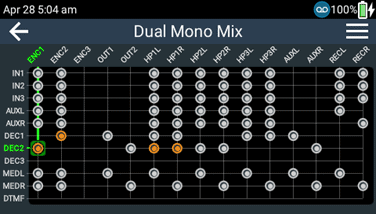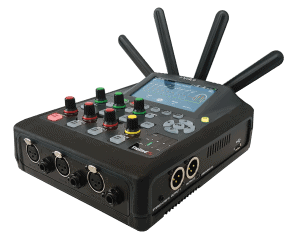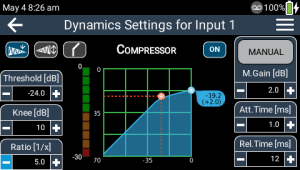Understanding and Configuring Mix-Minus Feeds
What is a Mix-Minus?
 A mix-minus is a broadcast term describing the feed sent from the studio to a remote site, so that the remote site can hear the studio output, without hearing itself back. When setting up an IFB mix-minus for remotes, the feed from the studio normally includes a full mix of the studio master mix output (master mix bus), minus incoming audio from the remote site.
A mix-minus is a broadcast term describing the feed sent from the studio to a remote site, so that the remote site can hear the studio output, without hearing itself back. When setting up an IFB mix-minus for remotes, the feed from the studio normally includes a full mix of the studio master mix output (master mix bus), minus incoming audio from the remote site.
Why is a Mix-Minus Required?
Typically, a mix-minus is used by ENG crews, radio and television news reporters and remote trucks, to facilitate live crosses requiring bidirectional communications.
Sending a mix-minus feed from the studio allows the remote site to hear studio broadcast audio without hearing the audio from the remote site back on delay. Audio sent via satellite or IP technologies from a remote site has inherent delay on both the transmit and return paths. It is a significant distraction for talent to hear this audio back at the remote site on delay.
As an example, if the IP audio latency between the remote site and the studio is 250ms, and the latency back from the studio is also 250ms, then the round-trip delay is 500ms or half a second. Without a mix minus, remote site announcers hear the full mix back from the studio, including their own audio on delay. This creates an ‘echo effect’ and makes it very difficult to maintain broadcasting.
In the early days, a mix-minus was often fed via an analog telephone hybrid, but increasingly these days it is distributed over IP using devices like smartphone codec apps and audio codecs. Connections over IP nowadays have relatively low latency over robust cellular and broadband data networks. As a result, often the round trip latency over IP is much less than half a second using the latest streaming technologies.
Multiple Live Crosses Require Multiple Mix-Minuses
With multiple simultaneous live crosses, it is important to create separate mix-minuses for each remote location. This is often configured using a mix bus on the studio mixing console. Typically, a separate mix bus will used to send an auxiliary mix-minus feed to each location. This can be tailored for each destination.

Overview of Configuring Mix-Minus Feeds using Tieline Codecs
It is also possible to configure a mix-minus in a Tieline codec. For example, perhaps you have a commentator calling play-by-play coverage of a sporting event from home. The event may be occurring in another city, or even another country. The announcer at home can call the game ‘off-tube’ using a video feed, while another announcer, perhaps working from the sideline at the sporting event, can use another codec to dial the announcer at home and communicate with them in real-time. Both of these codecs can stream audio back to the home studio to integrate into a mixed output.
This scenario is displayed in the following image.

Creating a Mix-Minus in the ViA Codec
The latest Tieline codecs include a crosspoint Matrix Editor allowing flexible routing of audio signals and the creation of mix-minus feeds. Similar to the previous example, a ViA codec used by a commentator at home has been configured with a customized dual mono supporting two independent mono connections; one to stream the commentor at home’s audio back to the studio (Encoder/Decoder 1 in following example); another connection to stream bidirectional audio with a sideline commentator at the sporting event (Encoder/Decoder 2 in following example).
The Matrix Editor in the ViA remote codec at the commentator’s home has been configured to route incoming audio from the other announcer’s codec (Decoder 2) on the sideline at a sporting event to the headphone output (HP1L and HP1R). This feed is also added into the program mix sent back to the studio, by routing Decoder 2 to Encoder 1. We also need to send a clean mix-minus feed back to the sideline reporter over Encoder 2, so inputs are sent, plus Decoder 1 which is the studio return program feed with talkback cues if required.

With this setup the announcer at home can simultaneously receive audio in real-time from the sideline commentator at the venue, as well as from the studio if required. The commentator at home can also stream his own audio back to the studio over one connection and to the sideline commentator using a second connection.
Both the commentator at home and the sideline commentator also monitor the mix-minus on the return feed from the studio, to listen to studio output and receive director and producer cues.
Real-World Applications Using Tieline Codecs
Thousands of Tieline customers use mix-minus to facilitate live remotes every day. The Tieline Gateway Multichannel IP codec also has a Matrix Router and can connect up to 16 remote connections. Using the Gateway codec, mix-minus routing can be configured for up to 16 different feeds at remote sites.


The Tieline ViA codec allows a bidirectional mono or stereo connection for program audio, plus a separate mono connection for sending IFB mix-minus communications from the studio. The touchscreen simplifies configuration of IFB signal routing onsite for remotes of any type. This makes it ideal for setting up an IFB mix-minus for remotes on the fly.
Want to know more?
For more information contact Tieline sales:
- For USA, Canada & Latin America contact: sales@tieline.com
- For Australia and International: info@tieline.com
To find out more information about the Gateway visit www.tieline.com/gateway, and for the ViA visit www.tieline.com/via.
(Configuring Mix-Minus Feeds was first published in May 2021)




